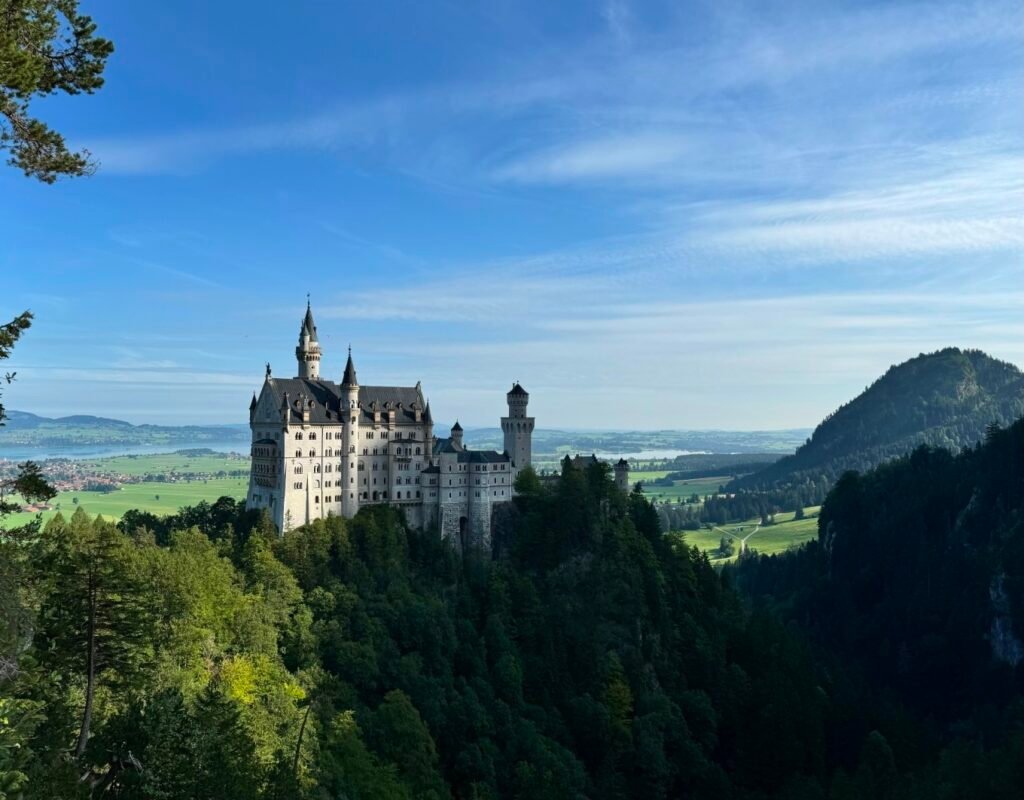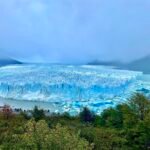Germany is rich in tourism resources, and Bavaria, located along the northern foothills of the Alps, borders Salzburg, Austria. Our journey will take us along the northern edge of the Alps, focusing on sightseeing across Bavaria’s top attractions.
In fact, Bavaria isn’t unfamiliar to most people. It’s home to the headquarters of BMW and FC Bayern Munich, a soccer team with international fame. And, of course, King Ludwig II’s Neuschwanstein Castle, the inspiration behind many fairytale castles, has made the region even more well-known.
Bavaria was once an independent kingdom, and today it’s the largest state in Germany. Its area is comparable to Austria, but with 1.5 times Austria’s population and even stronger economic power. Despite its highly developed economy, Bavaria has preserved its natural environment, and the picturesque countryside landscapes are like scenes straight out of a painting.
With only two days to explore, we’ve focused on must-see highlights for this trip: Neuschwanstein Castle, Königsee (King’s Lake), and the charming town of Oberammergau, known for its beautifully painted murals.


Neuschwanstein Castle was built by King Ludwig II of Bavaria. With its unique design and stunning scenery, it later became the model for many fairytale castles. The Alps stretch across southern Europe, with a portion running through Bavaria, home to some of Germany’s most breathtaking landscapes of lakes and mountains.
Nestled deep within the Alps, Königsee (King’s Lake) is Germany’s most pristine lake. The surrounding forests are said to be the inspiration for the enchanted woods in the Grimm Brothers’ fairy tales.
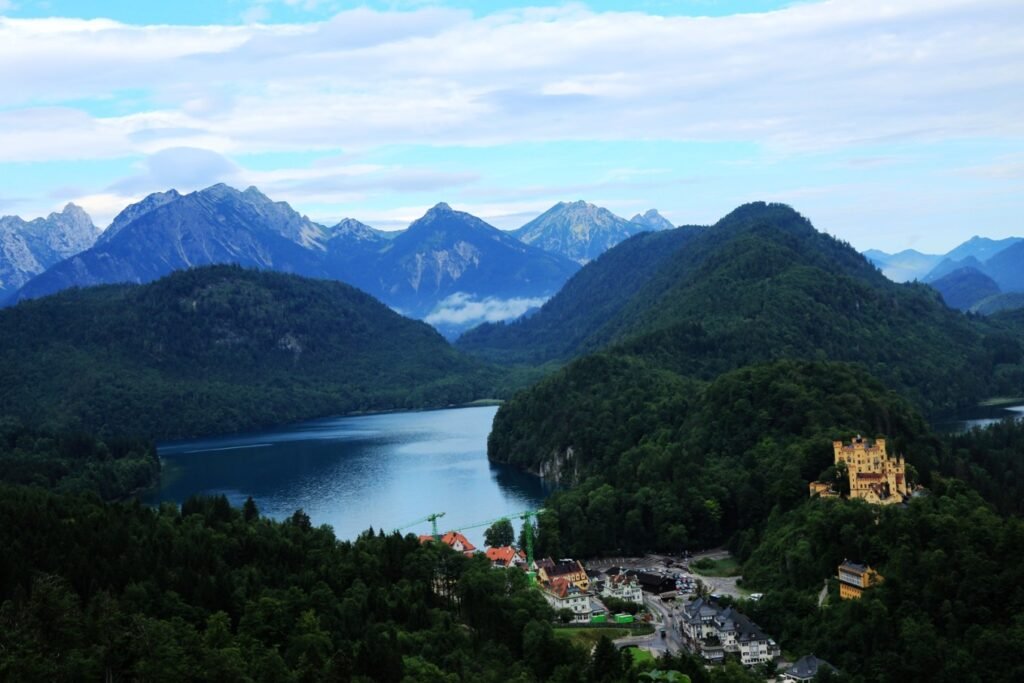
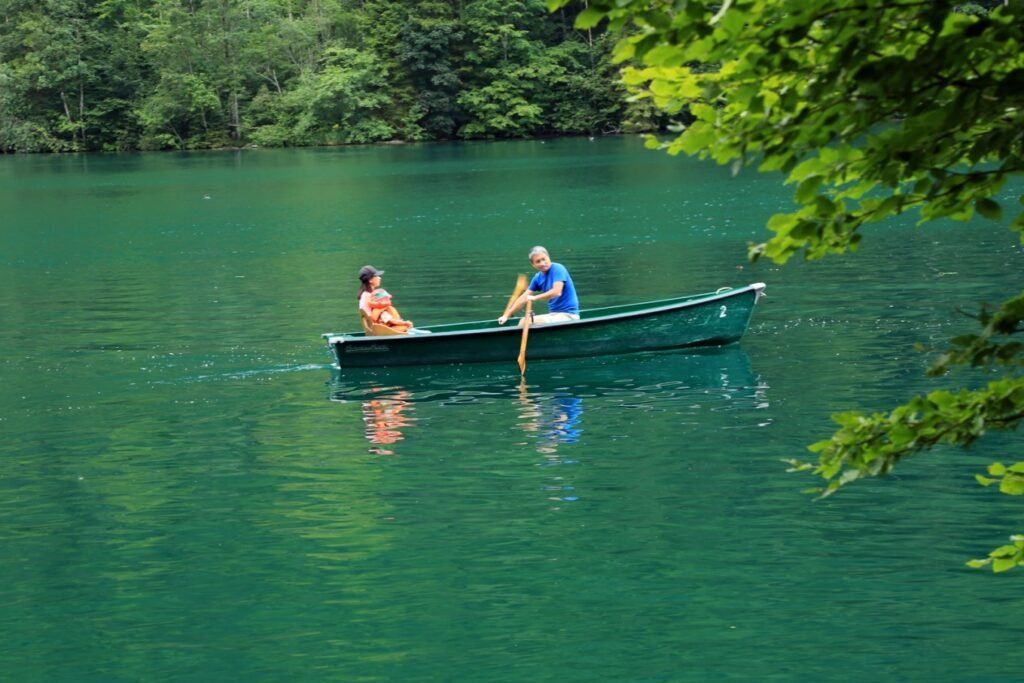
The mural town of Oberammergau is the epitome of a Bavarian countryside village. The murals on the exterior walls of the houses each tell their own story.
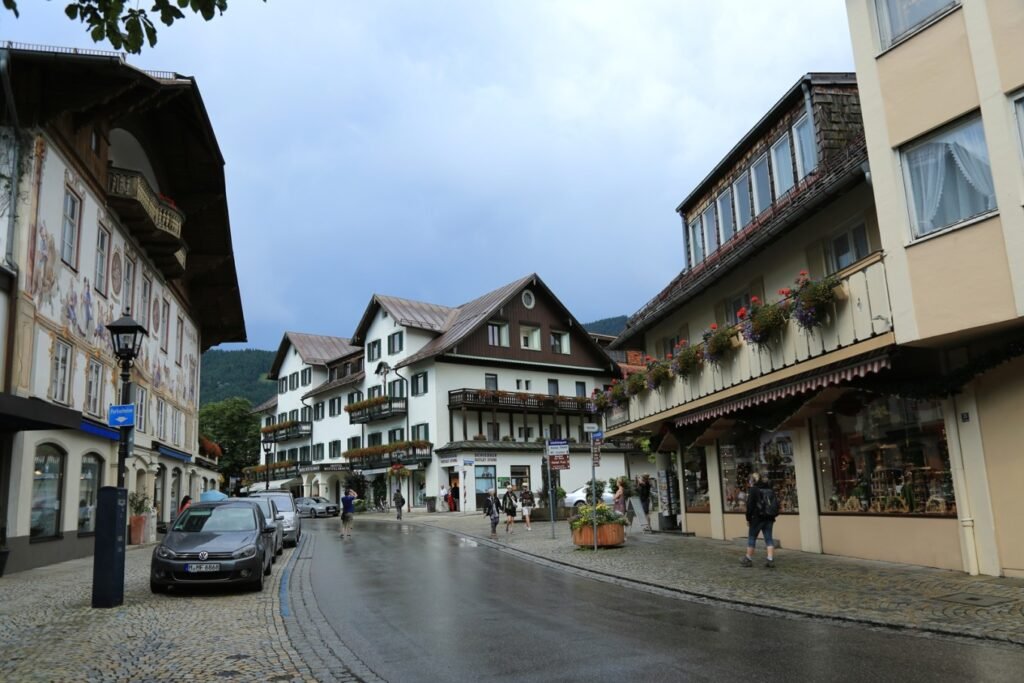
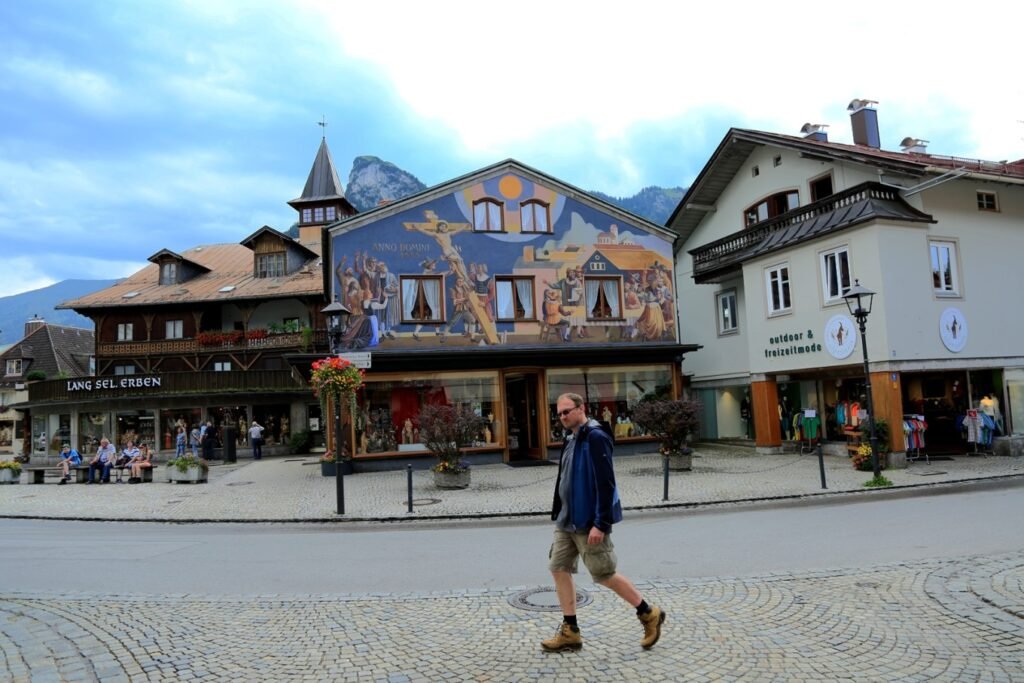
Bavarian cuisine wouldn’t be complete without trying roasted pork knuckle. With its crispy skin and tender meat, all wrapped in a golden-brown crust, it’s sure to whet your appetite.

Ottobeuren Abbey is a thousand-year-old monastery, and its interior is a masterpiece of 18th-century European Rococo architecture. Bavaria is one of the most scenic regions in Germany, offering two famous road trip routes.
The Alpine Road stretches from Lake Constance, near the German-Swiss border, to Königsee, on the German-Austrian border. The Romantic Road runs from Würzburg to Füssen, home of Neuschwanstein Castle. Both routes crisscross Bavaria from east to west and north to south, taking travelers through forests, lakes, mountains, meadows, and countless historical landmarks along the way.
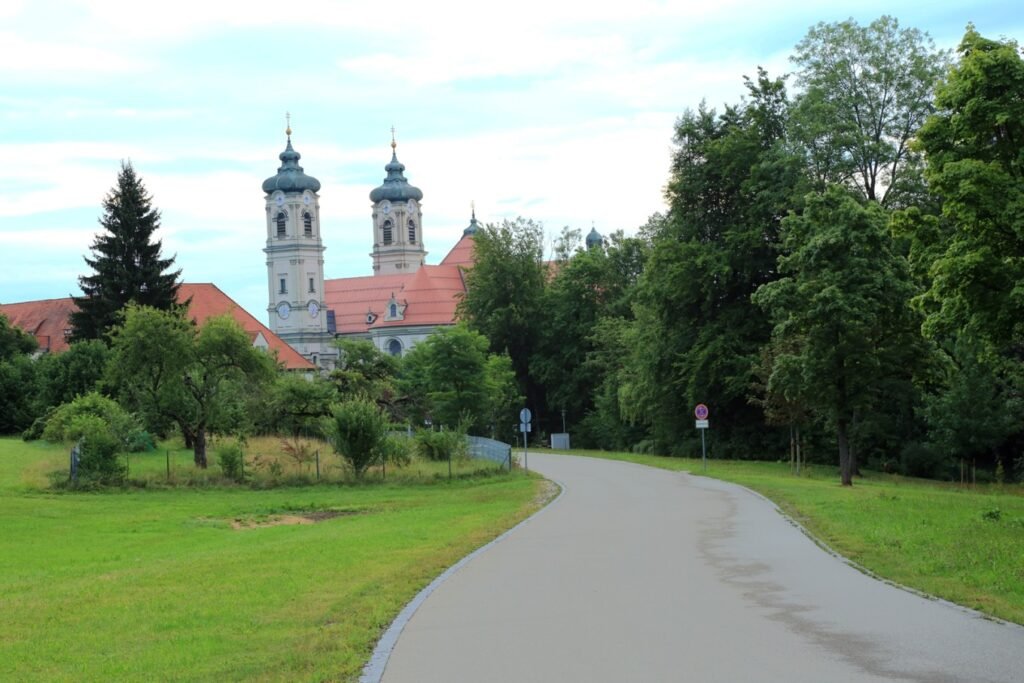
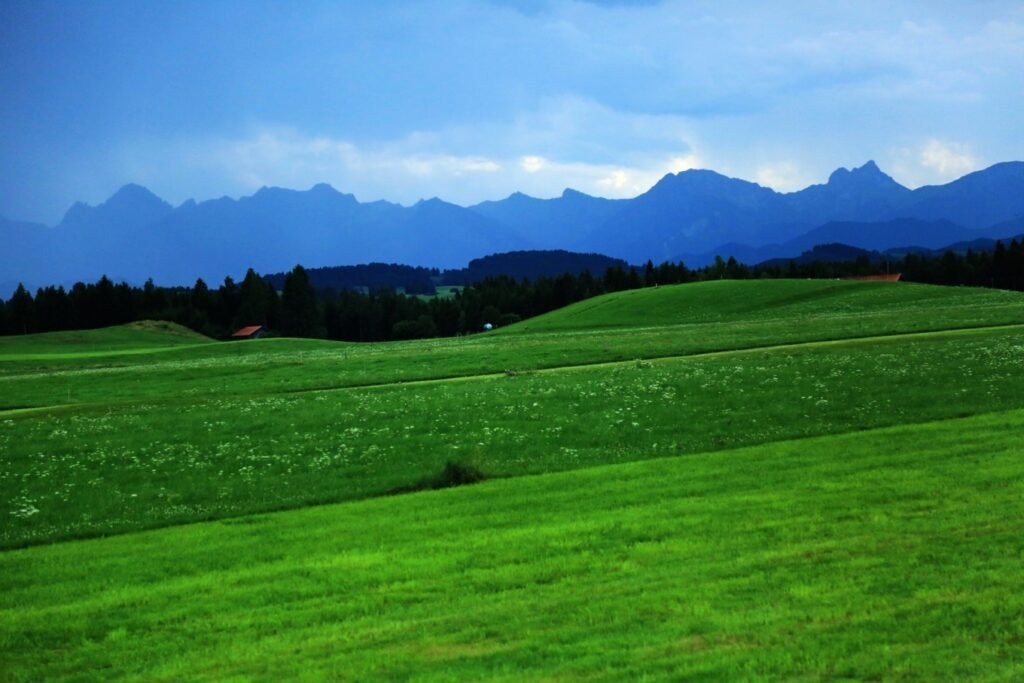
Königsee in Berchtesgaden
Our Bavarian journey begins at Königsee, located in the Berchtesgaden region, just under an hour’s drive from Salzburg. This area is home to Germany’s first national park in the Alps. Berchtesgaden offers not only breathtaking lakes and mountains but also a wealth of historical sites, making it one of Germany’s favorite vacation destinations.
Interestingly, Berchtesgaden used to be part of Austrian territory. Legend has it that a Bavarian king, eager for scenic escapes, traded fertile farmland with Austria to acquire this area for hunting and leisure. At the time, the trade was seen as foolish. However, today, the flood of tourists visiting the region has turned it into a major economic boon for Bavaria, far surpassing the value of the farmland given up—much like how the U.S. profited from buying Alaska from Russia.
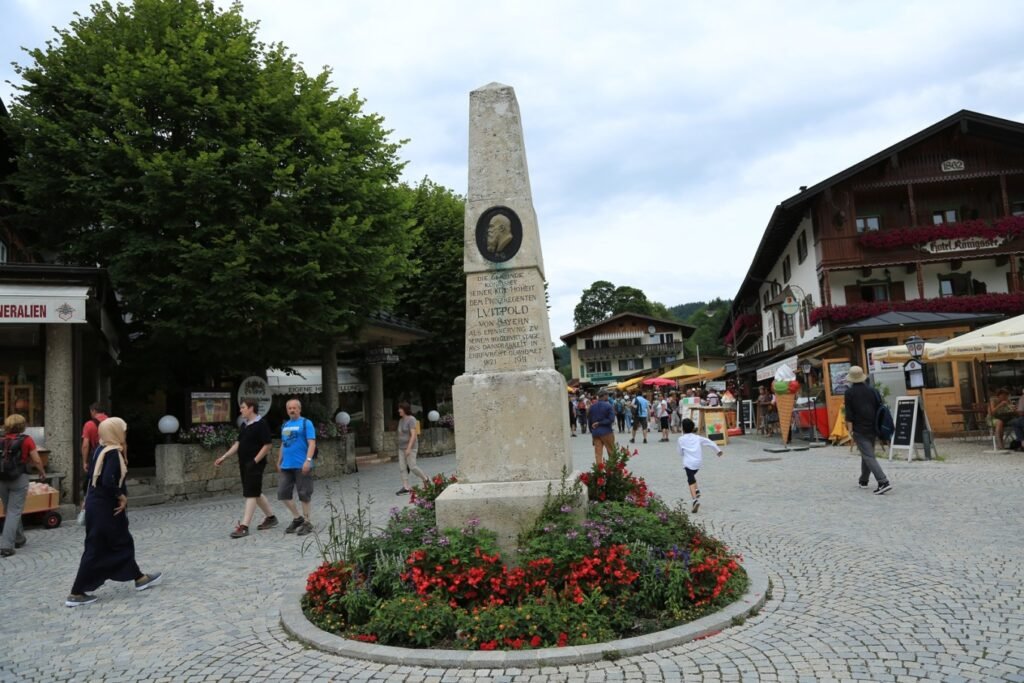
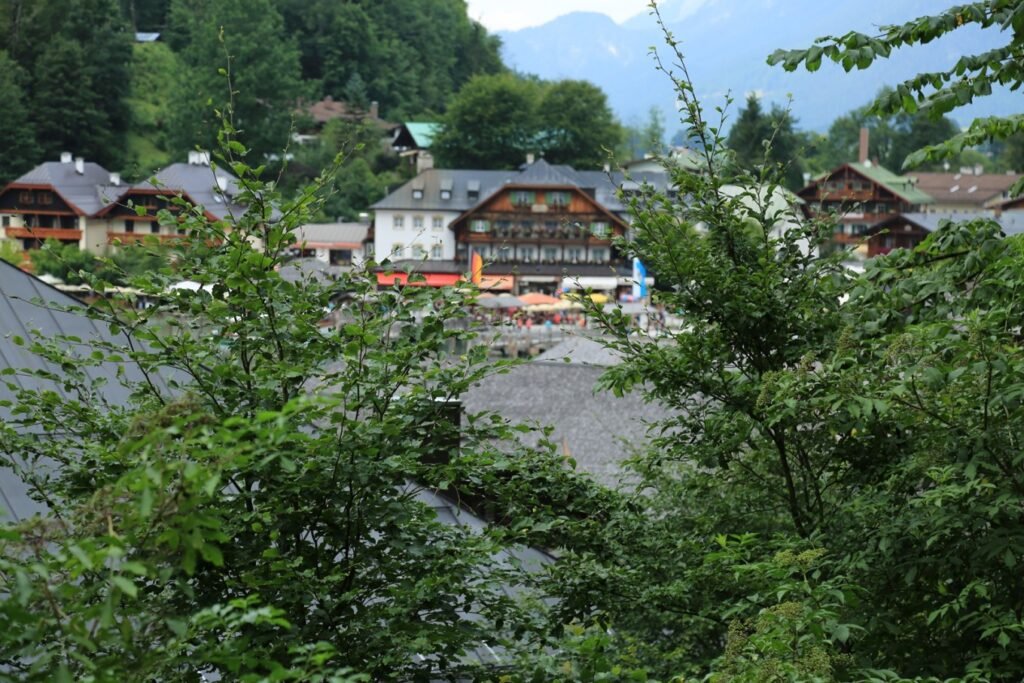
To the east, south, and southwest, Berchtesgaden is surrounded by Salzburg, Austria, making it look like a wedge embedded in Austria’s map. Despite its small size, this region boasts some of Germany’s most stunning natural attractions, including Königsee and Watzmann, the country’s second-highest peak. It’s also home to forests reminiscent of those in Grimm’s fairy tales, as well as Hitler’s WWII-era mountain retreat, the Eagle’s Nest.
The Eagle’s Nest sits high atop the mountain and was originally designed to host official guests. The road from the base doesn’t take you directly to the villa—it leads to a platform at 1,700 meters (5,577 feet) above sea level. From there, visitors must take an elevator built into the mountain to reach the villa. Some of WWII’s most significant decisions were made there, but unfortunately, due to limited time, we couldn’t go up for a visit.
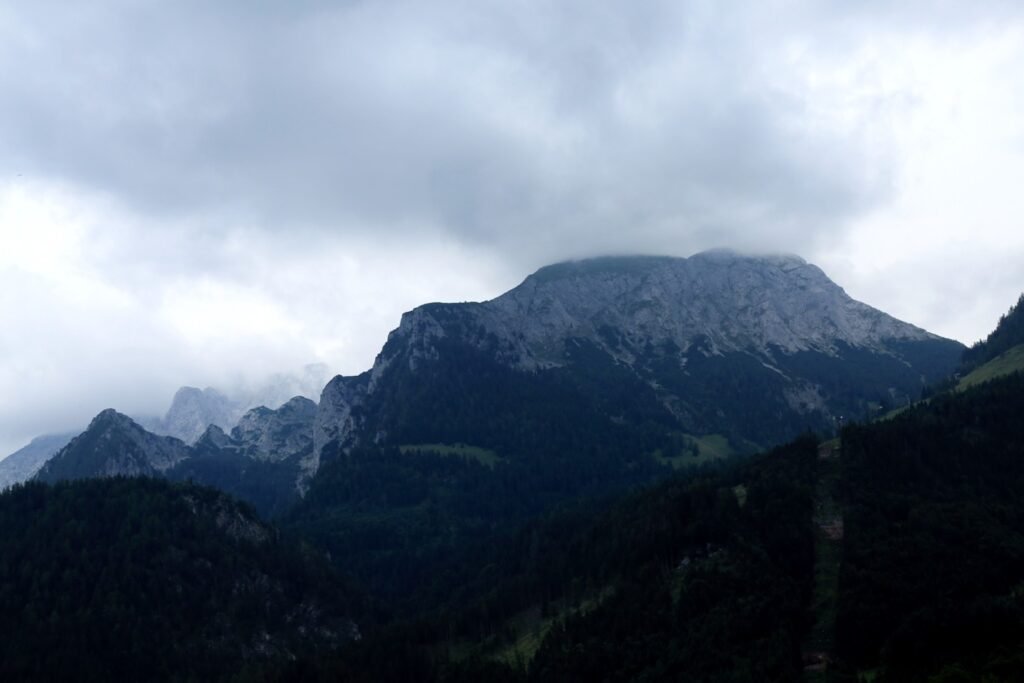
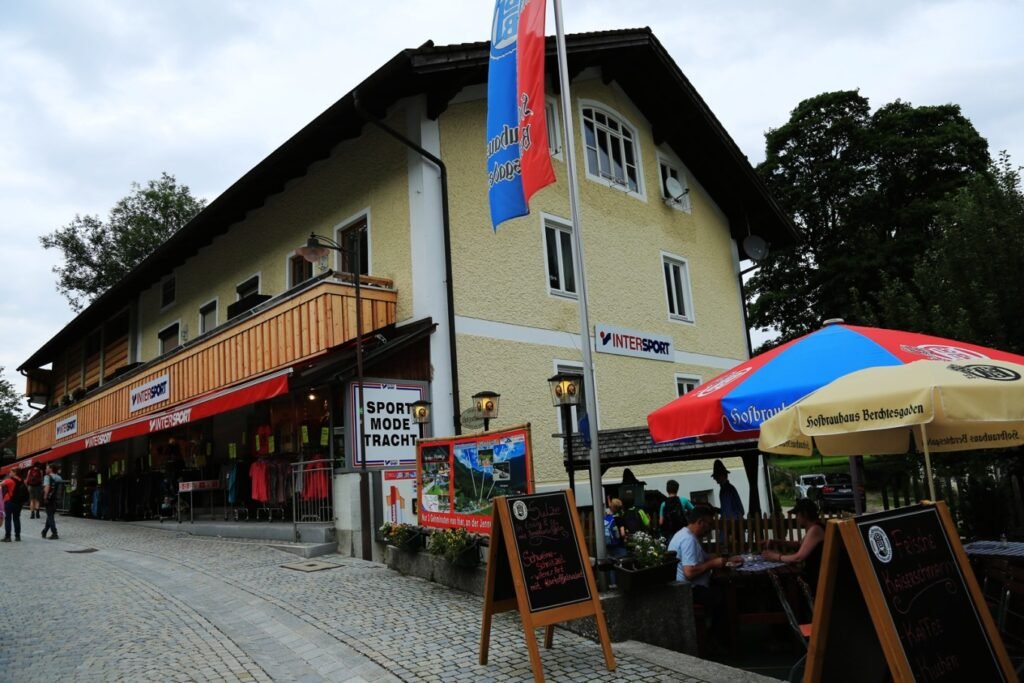
The area around Königsee is full of hotels and restaurants, and it’s always lively. In the summer, visitors come to escape the heat, and in the winter, it’s a popular skiing destination. But autumn is arguably the most beautiful season here. Originally named Königssee, the lake was later dubbed “King’s Lake” because it used to be a vacation spot for the Bavarian royal family. Nearby, the Berchtesgaden Palace served as their residence during stays.
Königsee is a long, narrow lake nestled between two mountains, with steep cliffs and dense, untouched forests lining its sides. Deep within the lake area stands a charming onion-domed chapel, but the only way to reach it is by electric boat, with a round trip taking 2-3 hours. Unfortunately, due to time constraints, we couldn’t take the boat ride and had to settle for enjoying the scenery from the shore.
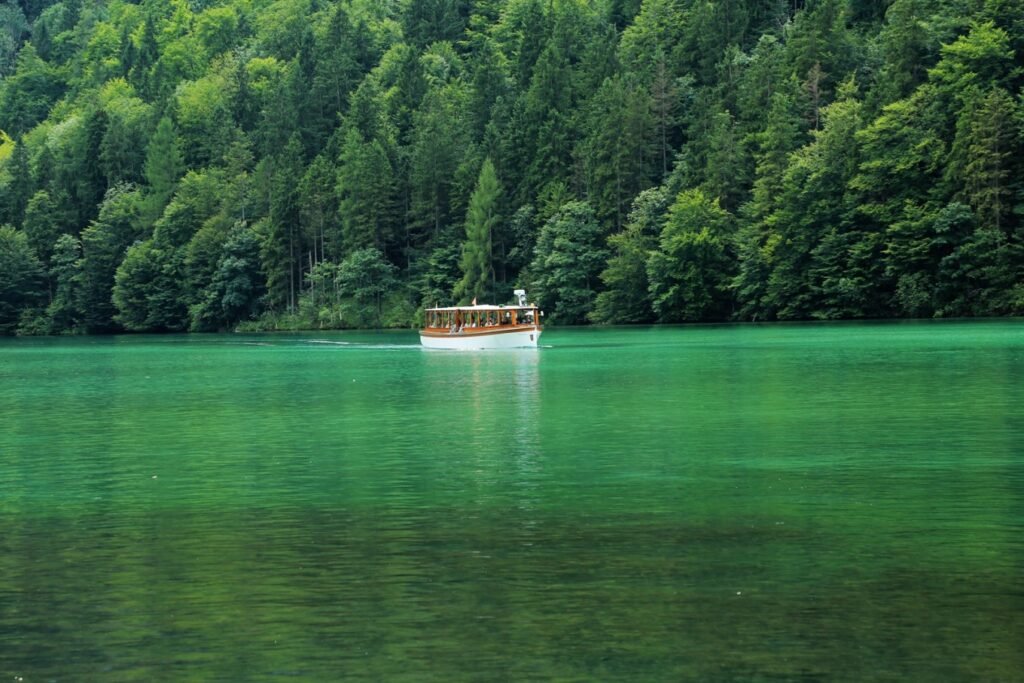
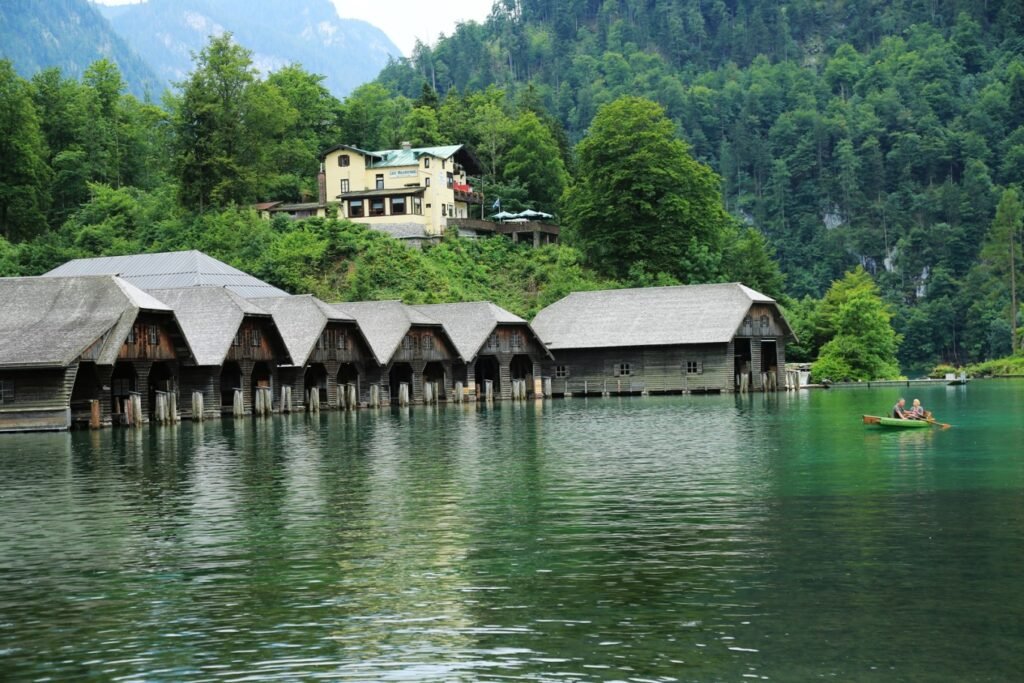
Königsee is celebrated as Germany’s most beautiful and pristine lake. Its crystal-clear, emerald-green waters shine like a gem set among the towering peaks of the Alps. Since 1909, all activities that could pollute the lake have been strictly prohibited. Even boats on the lake are limited to rowboats and electric boats, ensuring that Königsee remains as clear and pure as ever.
There’s no denying that Königsee is an absolutely stunning destination, with both the lake itself and its surrounding environment offering unparalleled beauty.
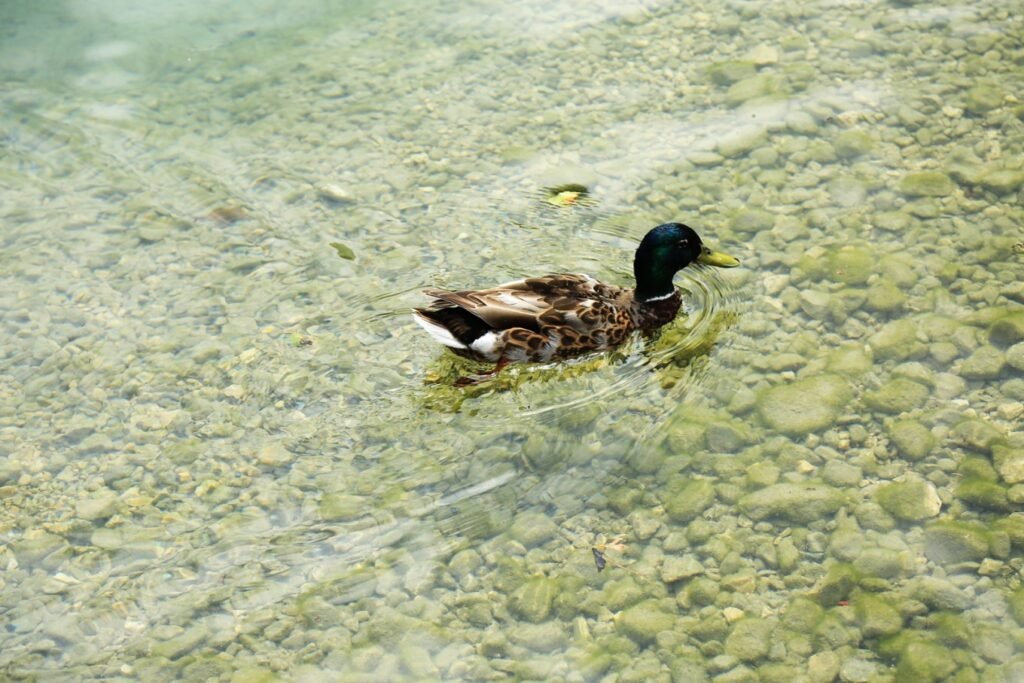
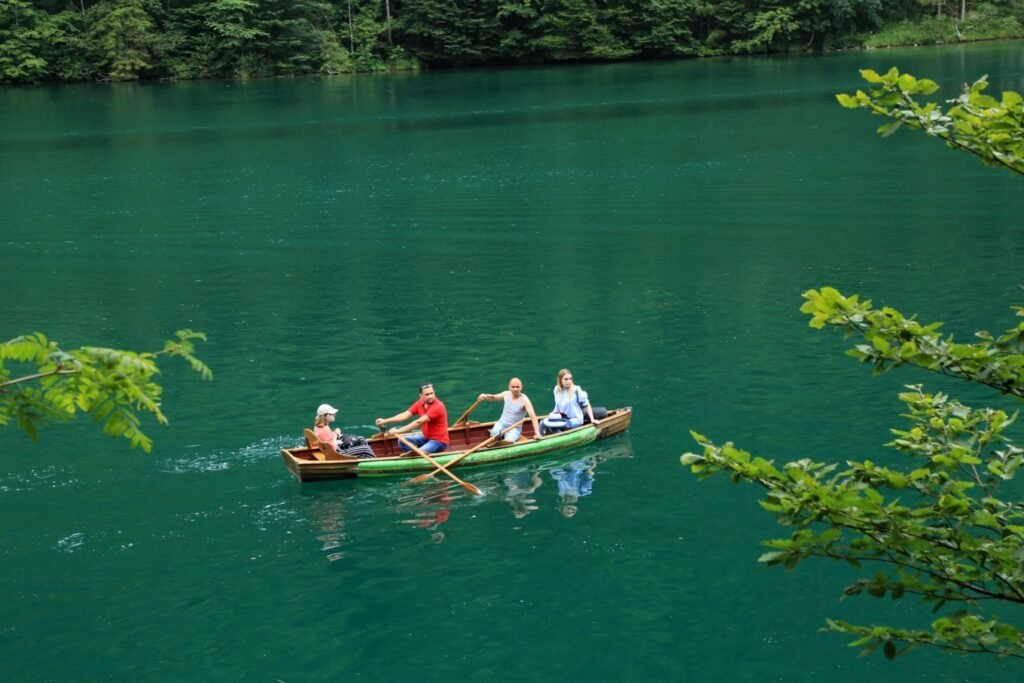
The Enchanted Forests Around Königsee
A third of Bavaria’s land is covered by forests, with most of them concentrated along the northern foothills of the Alps near the Austrian border. These areas are sparsely populated, leaving many forests in their untouched, primeval state. Berchtesgaden National Park, where Königsee is located, is home to several fairy-tale forests that feel straight out of a storybook. It’s said that many of the tales in Grimm’s Fairy Tales were inspired by these very woods.
Walking along the trail next to Königsee’s dock feels like stepping into a fairy-tale world. There are no paved paths—just a soft forest floor carpeted with fallen leaves. As you make your way deeper into the woods along the lakeshore, the emerald-green waters peek through the trees, enhancing the forest’s magical, untouched atmosphere.
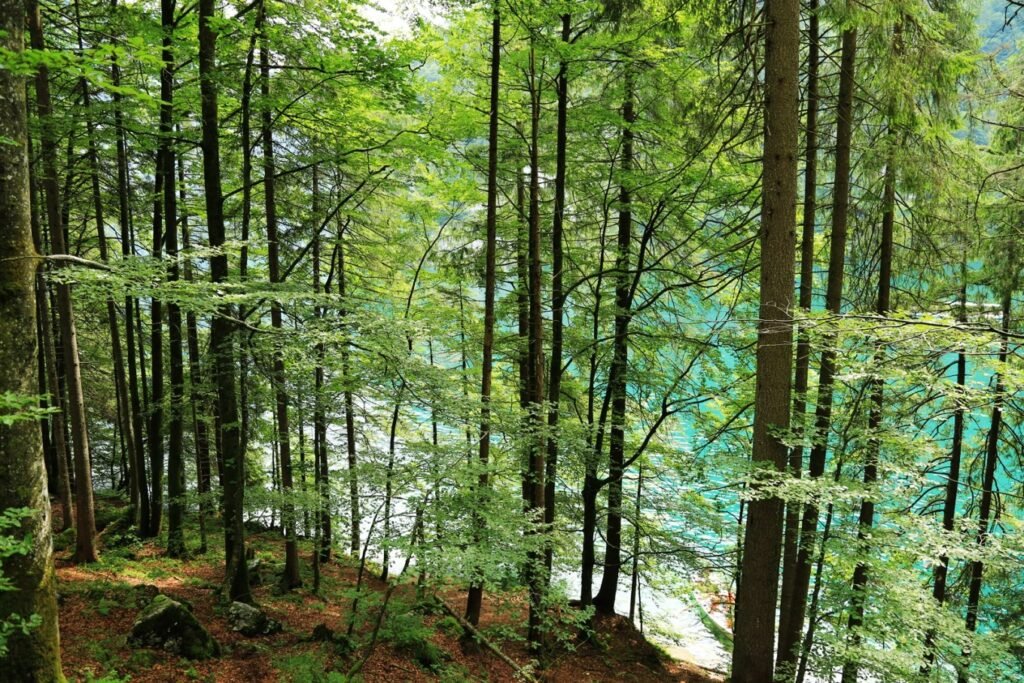
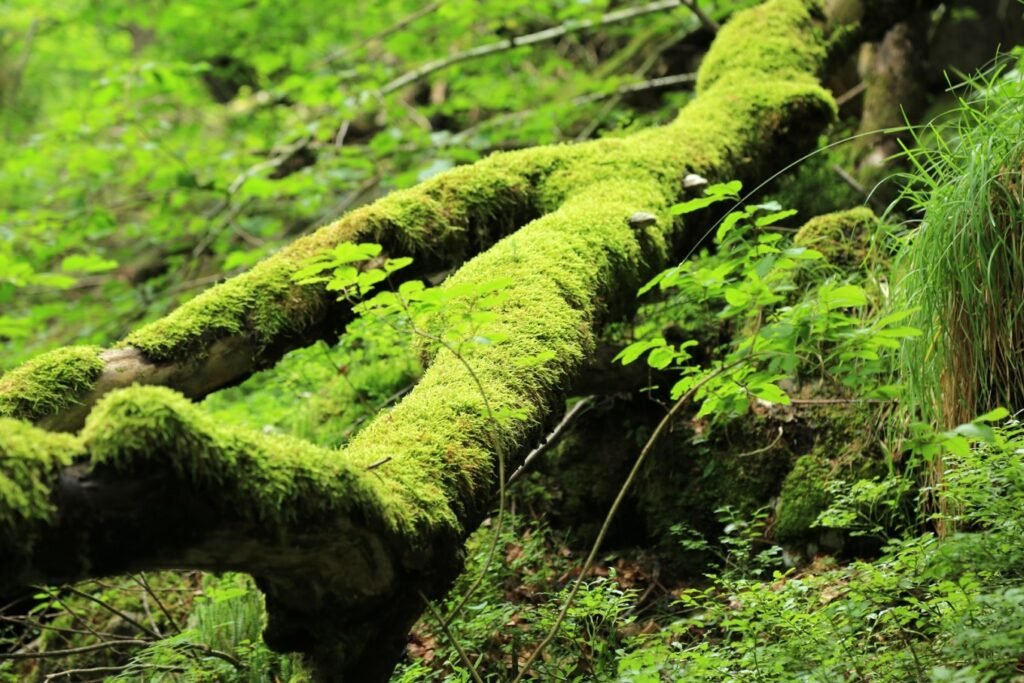
The ground, covered in fallen leaves and moss, makes it feel like you’ve stepped into a magical world. Beyond the beautiful scenery, there’s also a mysterious and eerie atmosphere. Walking alone in such a forest can feel unsettling. As the saying goes: “Places without human presence are either touched by spirits or haunted by demons.” According to European mythology, deep forests are home to mountain trolls, and with enough time, even dead trees and rocks can transform into magical creatures.
With that in mind, I didn’t dare venture too far into the forest. After walking for a while, I decided to turn back. But I can only imagine how much more breathtaking the forest must be deeper inside.
The Mural Town – Oberammergau
Oberammergau is a key stop along Germany’s famous Alpine Road, making it a must-visit destination on the route from Neuschwanstein Castle to Königsee. Travelers on this scenic journey rarely miss the chance to explore this charming town, known for its beautiful natural scenery and rich cultural heritage.
Oberammergau is the birthplace of Franz Zwink, the founder of Lüftlmalerei (a style of fresco painting). According to legend, Zwink began painting murals on the exterior walls of his home out of boredom. Inspired by his creativity, other townspeople followed suit, giving rise to the mural-filled town we see today.
Nestled in a flat valley at the foot of the Alps, Oberammergau is surrounded by mountains, forests, and meadows. The houses are scattered across the landscape, blending harmoniously with the natural surroundings, creating a picturesque scene straight out of a postcard.
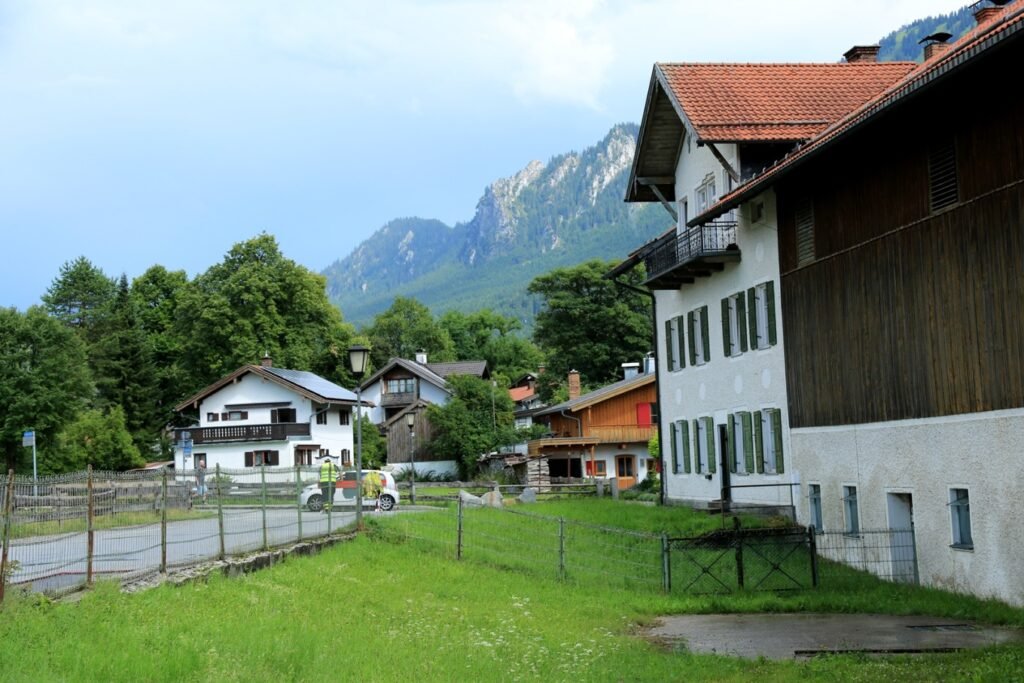
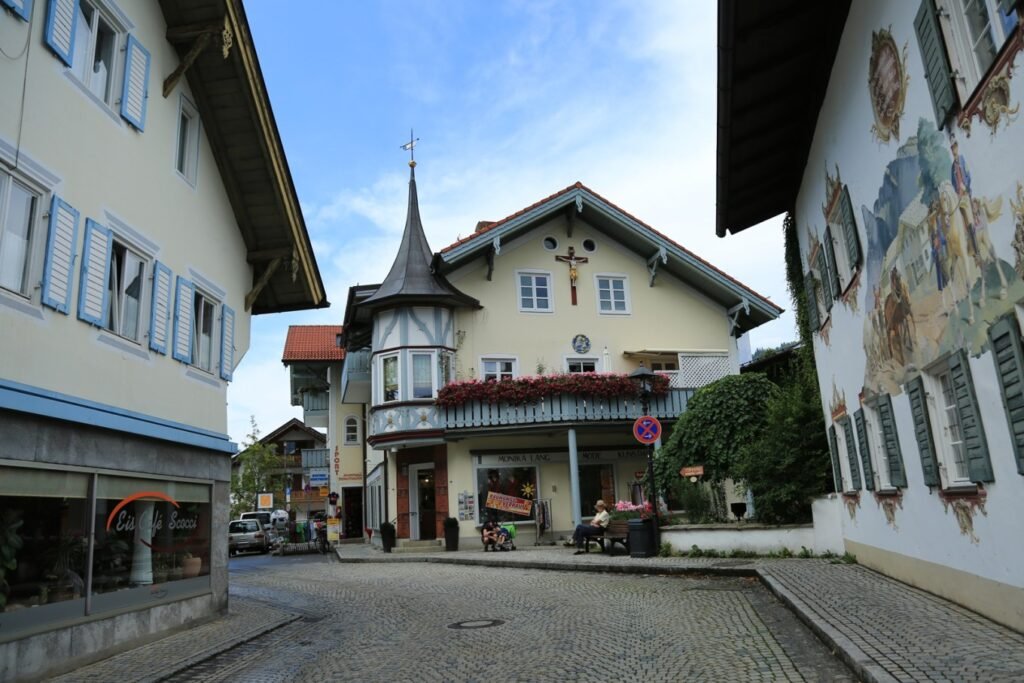
The heart and soul of Oberammergau lies in its murals. Nearly every building’s exterior is adorned with large frescoes, most depicting stories from the Bible or fairy tales. It feels as if each house is telling a story of its own.
The most captivating mural in town is The Passion of Christ. According to legend, when the Black Plague swept through Europe in the 17th century, the people of Oberammergau prayed to God for protection. Miraculously, the plague spared the town. Believing this to be a sign from Jesus, the townspeople vowed to stage a grand Passion Play every ten years to express their gratitude. This mural was created to commemorate that tradition.
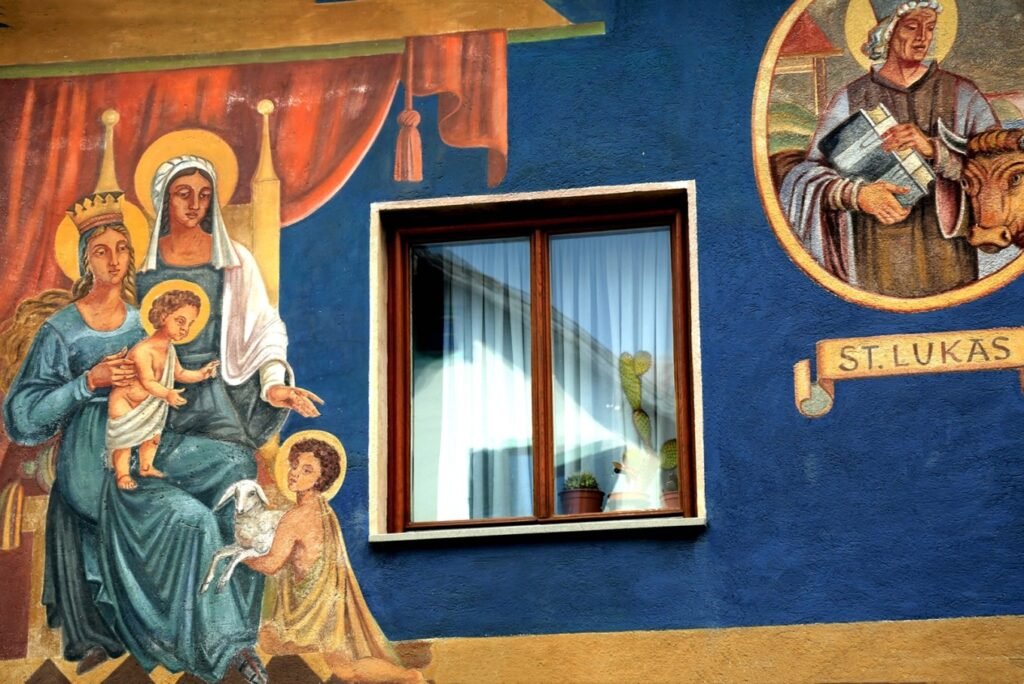
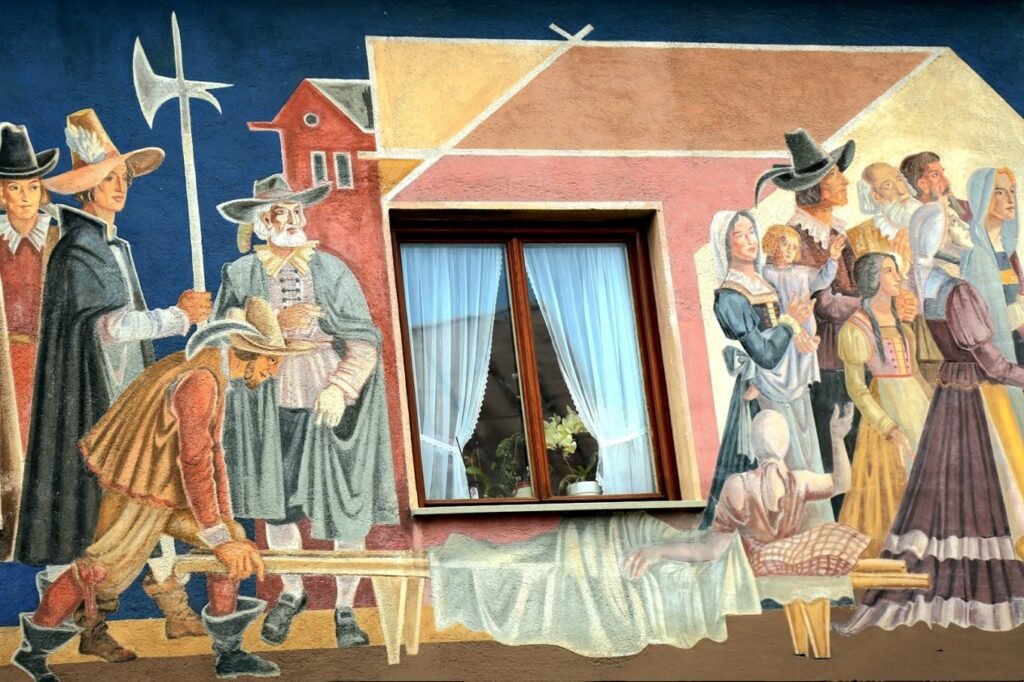
The murals of Oberammergau are created using a technique called fresco painting. First, a layer of wet plaster is applied to the exterior walls. While the plaster is still semi-dry, water-based pigments are painted directly onto the surface. As the paint slowly seeps into the plaster, it becomes embedded in the wall. Once the mural dries, it becomes remarkably durable, resisting fading from wind, rain, and sunlight over time.

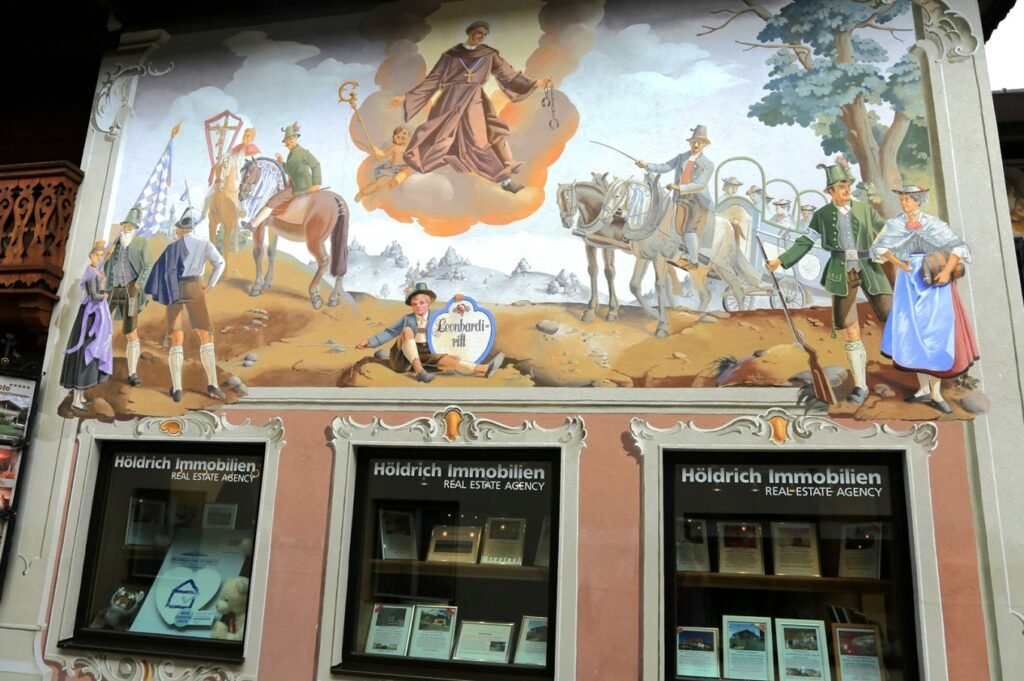
Exploring Germany’s Countryside Along the Alpine Road
Bavaria lies along the northern foothills of the Alps, with the terrain sloping from high mountains in the south to hills and plains in the north. Traveling from Königsee to Neuschwanstein Castle follows the famous scenic route known as the Alpine Road. Along the way, you’ll pass majestic mountains, dense forests, pastures, farmland, and quaint villages—each view like a beautiful landscape painting.
After World War II, Bavaria was part of the American occupation zone. During this period, the region’s industrial sector rapidly developed, while agriculture and livestock farming became less prominent. Many former pastures have since become part of the natural scenery.
Today, Bavaria’s economy is highly advanced, with industries such as automotive manufacturing, information technology, and modern services leading the way. Global giants like BMW, Audi, and Siemens have their headquarters here, and small businesses are scattered across the region’s many villages and towns.
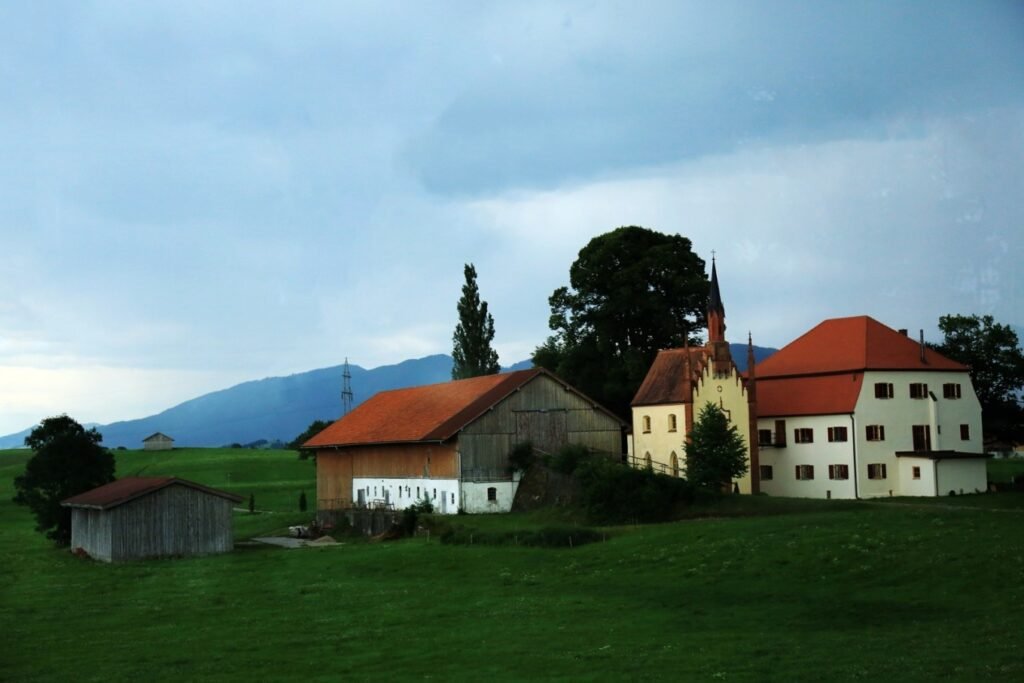
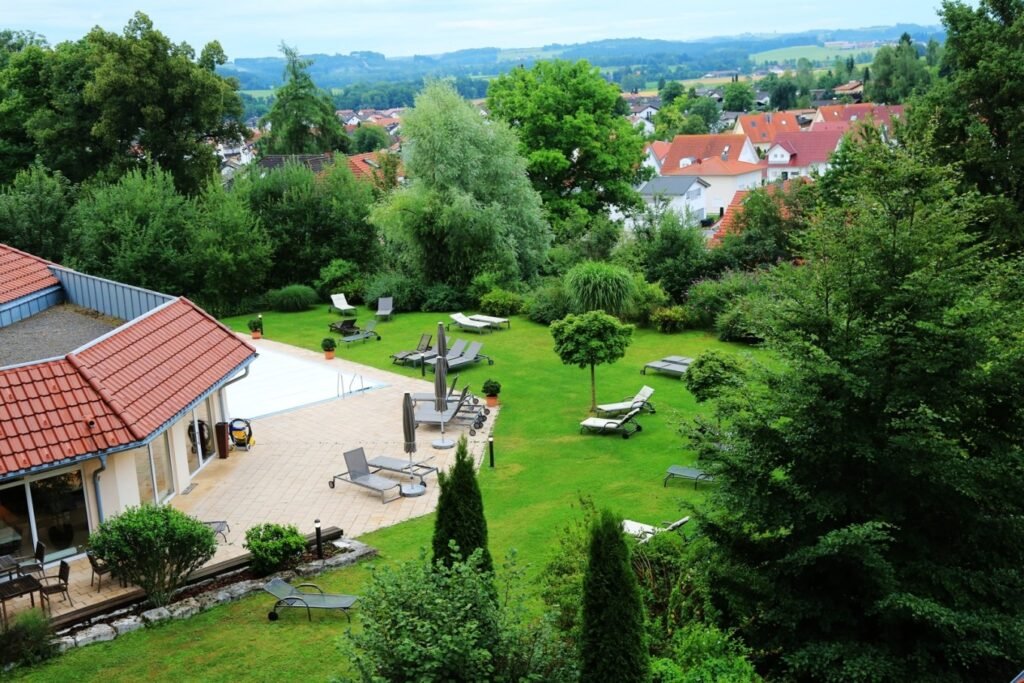
A Fairytale Castle – Neuschwanstein
Germany, often called the “Kingdom of Castles,” is home to about 14,000 castles, but Neuschwanstein is undoubtedly the most famous of them all. Nestled at the foothills of the Alps in southwestern Bavaria near the Austrian border, the castle sits atop a steep hill, with its striking silhouette visible from afar.
Neuschwanstein is situated at the intersection of two iconic German scenic routes—the Alpine Road and the Romantic Road—making it one of the country’s most popular tourist attractions. Construction of the castle began in 1869, designed and overseen by King Ludwig II of Bavaria. The project was incredibly costly and dragged on for years. By the time of Ludwig’s death in 1886, the castle was still unfinished.
Though Ludwig II lacked political skill, he possessed exceptional artistic talent, particularly in music and architectural design. The location and design of the castle were personally selected and envisioned by the king. If he hadn’t been born into royalty, he might well have become a master artist.
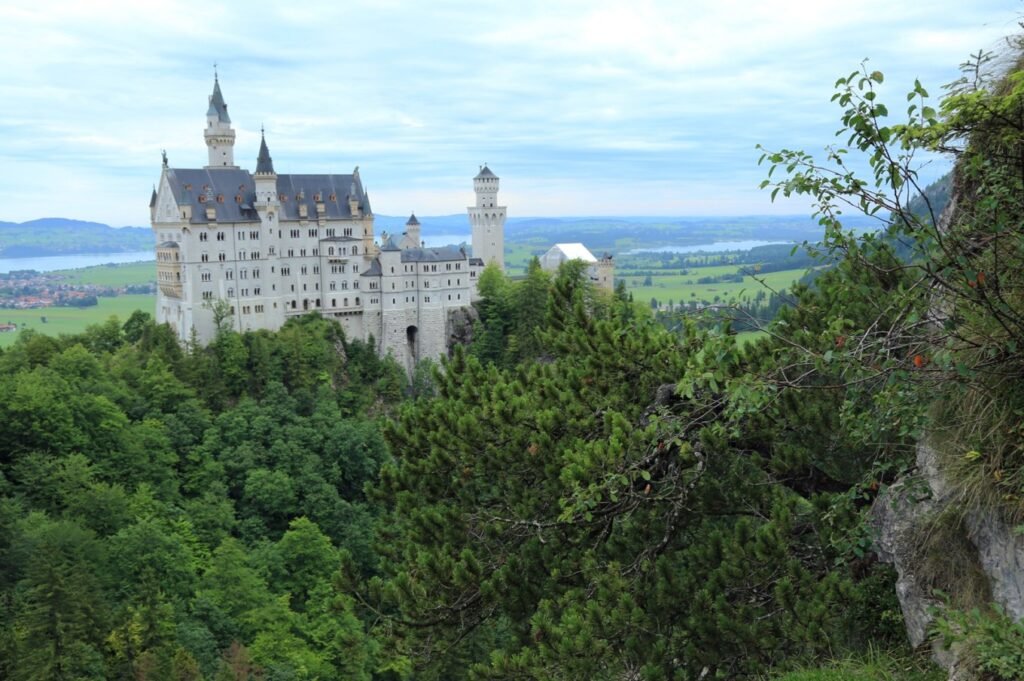
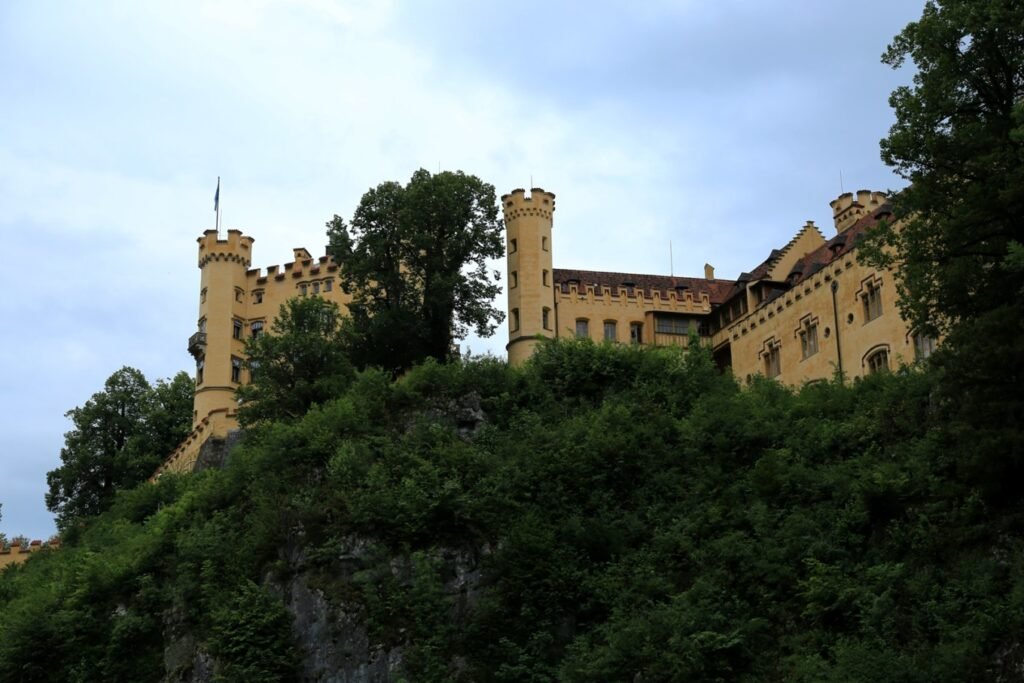
Across from Neuschwanstein Castle lies Hohenschwangau Castle, the residence of Ludwig II’s father, King Maximilian II. Ludwig spent his childhood at Hohenschwangau, which is itself a beautiful and uniquely designed castle, surrounded by stunning scenery. If not for the overshadowing fame of Neuschwanstein, Hohenschwangau would undoubtedly attract more attention.
Neuschwanstein is best appreciated from a distance, and the Marienbrücke (Mary’s Bridge), which spans a gorge, offers the most spectacular views of the castle. Known as one of the ten most beautiful castles in Europe, Neuschwanstein also served as the inspiration for Disney castles and many others in European fairy tales.
Perched atop a mountain, the castle enjoys a perfect natural setting, with a deep gorge on one side and gentle pastures on the other.
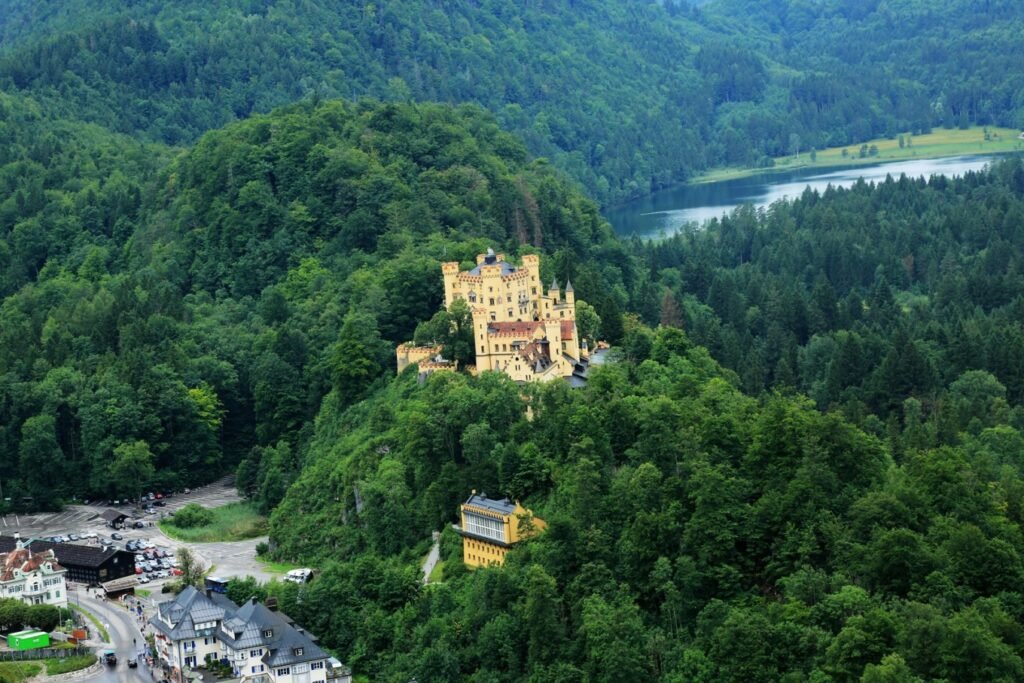
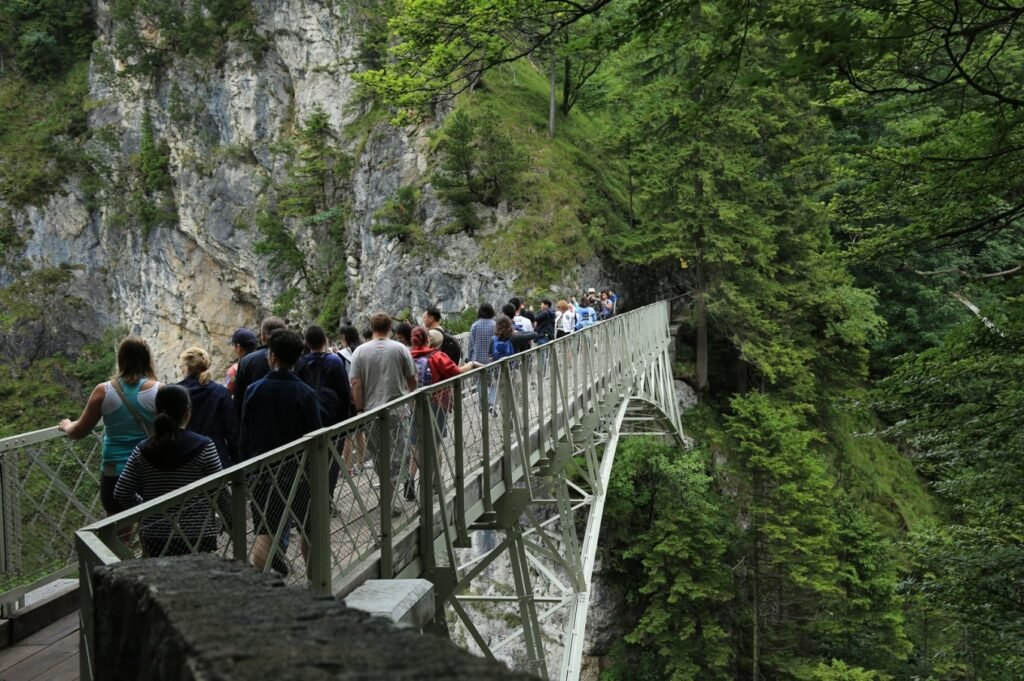
The rolling Alps stretch across the southern region of Neuschwanstein Castle, with the Austrian border only a few kilometers away in a straight line. The distant mountains you see are part of Austria’s territory. There are also two lakes nearby—the smaller Swan Lake to the right and the Alpine Lake to the left. Both lakes are surrounded by dense forests and towering mountains, adding to the stunning beauty of the landscape.
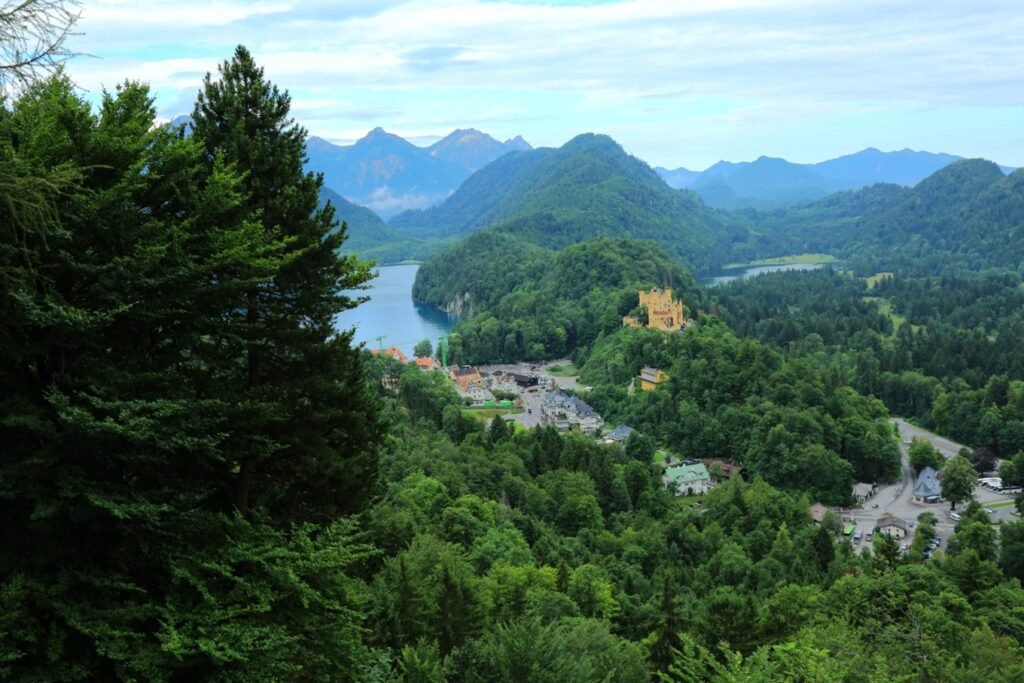
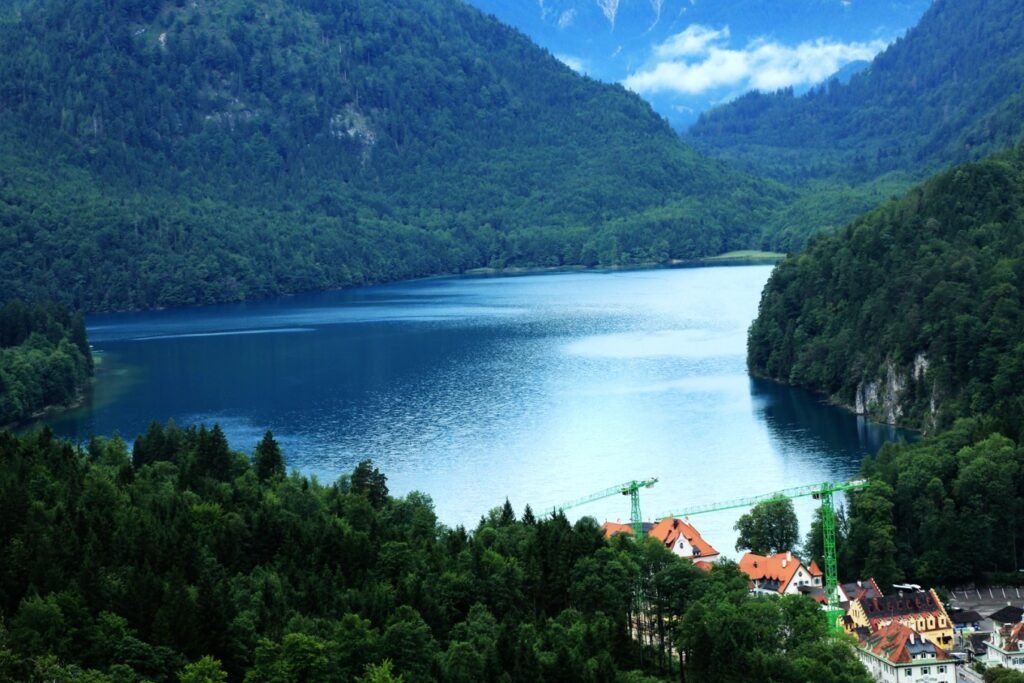
Neuschwanstein Castle has a total of 360 rooms, but only 14 were completed according to the original design before King Ludwig II’s death. The remaining 346 rooms were gradually finished after his passing. The castle’s interior is lavishly decorated, with many rooms featuring murals and meticulous details. Unfortunately, photography is not allowed inside, so I couldn’t capture anything to share.
Ludwig II was truly a legendary figure. He had little interest in power or romance, dedicating himself entirely to art. In fact, he could be considered one of the first celebrity fans. As a young man, he became obsessed with the operas of the famous composer Richard Wagner and even built a theater just for Wagner’s performances. Neuschwanstein Castle itself includes a music hall.
Ludwig’s only romantic attachment was to his cousin, Empress Elisabeth of Austria, better known as Sissi. After Sissi married into the Austrian royal family, Ludwig lost interest in other women. At one point, Sissi tried to introduce Ludwig to her sister, Princess Sophie, and the two became engaged. However, just before the wedding, Ludwig heard that Wagner was performing and canceled the ceremony to attend the concert instead.
The construction of Neuschwanstein drained Ludwig’s finances. He spent all of his savings on the project and even borrowed heavily from Prussia. Eventually, he couldn’t repay his debts and was forced to integrate Bavaria into what would become the German Empire. Despite his poor governance, Ludwig remained beloved by the people—probably because he was both handsome and talented. It’s said that even today, Bavarians abroad often identify as Bavarians rather than Germans.
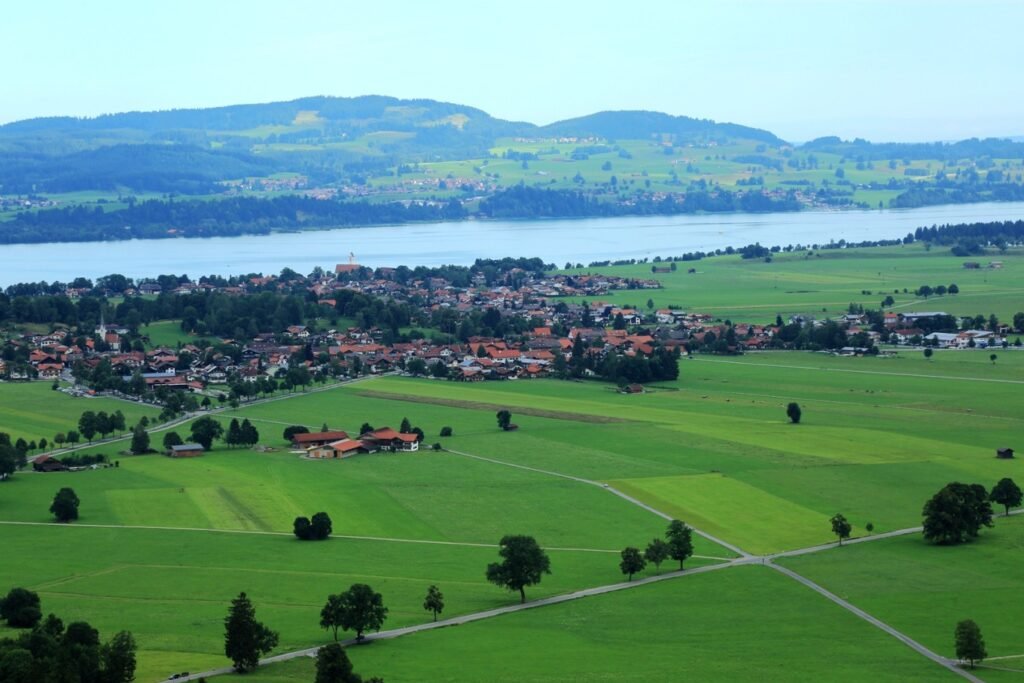
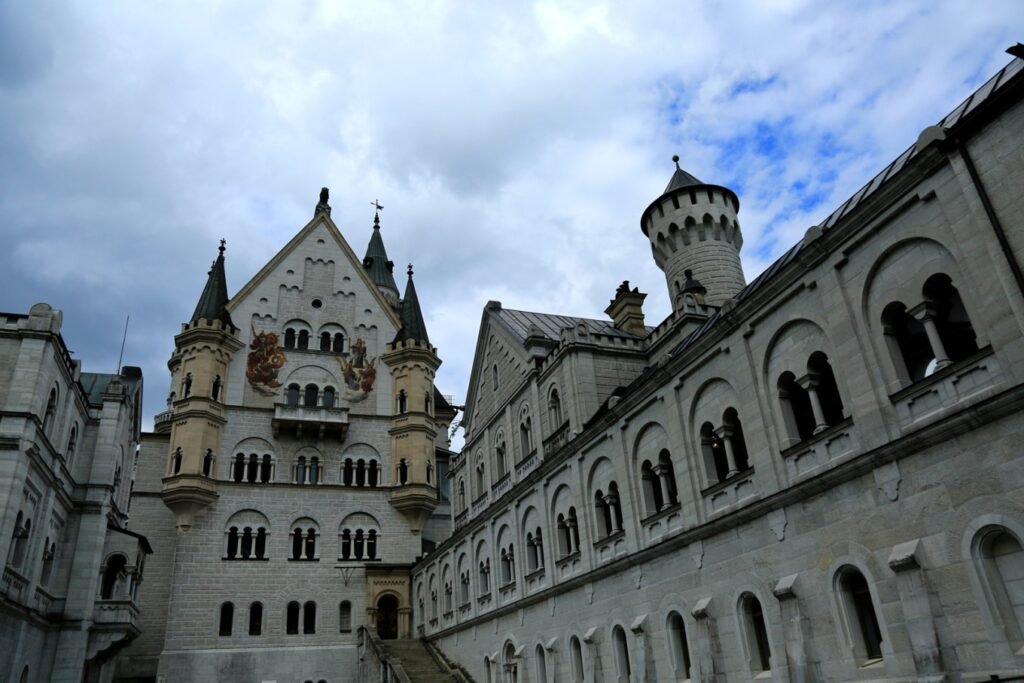
Bavaria boasts the most beautiful scenery in Germany, with the country’s finest lakes and mountain landscapes concentrated here. This region is ideal for road trips, as some of the most breathtaking sights can be discovered along the way. Unfortunately, with only two days to explore, we had to limit ourselves to the attractions along our route.

